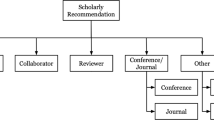Abstract
Expertise Oriented Search (EOS) aims at providing comprehensive expertise analysis on data from distributed sources. It is useful in many application domains, for example, finding experts on a given topic, detecting the confliction of interest between researchers, and assigning reviewers to proposals. In this paper, we present the design and implementation of our expertise oriented search system, Arnetminer (http://www.arnetminer.net). Arnetminer has gathered and integrated information about a half-million computer science researchers from the Web, including their profiles and publications. Moreover, Arnetminer constructs a social network among these researchers through their co-authorship, and utilizes this network information as well as the individual profiles to facilitate expertise oriented search tasks. In particular, the co-authorship information is used both in ranking the expertise of individual researchers for a given topic and in searching for associations between researchers. We have conducted initial experiments on Arnetminer. Our results demonstrate that the proposed relevancy propagation expert finding method outperforms the method that only uses person local information, and the proposed two-stage association search on a large-scale social network is order of magnitude faster than the baseline method.
Similar content being viewed by others
References
Citeseer. http://www.citeseer.nec.com
Aleman-Meza B, Nagarajan M, Ramakrishnan C, et al. Semantic analytics on social networks: experiences in addressing the problem of conflict of interest detection. In: Proceedings of www’ 06. New York: ACM, 2006, 407–416
Hettich S, Pazzani MJ. Mining for proposal reviewers: lessons learned at the national science foundation. In: Proceedings of KDD’ 06. New York: ACM, 2006, 862–871
Golbeck J. Web-based social networks: a survey and future directions. Technique Report
Brickley D, Miller L. FOAF vocabulary specification. Namespace Document, http://xmlns.com/foaf/0.1/
Kruk S R, Decker S. Semantic social collaborative filtering with FOAFRealm. In: Proceedings of the Semantic Desktop Workshop. Galway, Ireland, 2005
Foafnaut. http://www.foafnaut.org/
Culotta A, Bekkerman R, McCallum A. Extracting social networks and contact information from email and the web. In: Proceedings of Email and Spam. AAAI 2004
Kautz H, Selman B, Shah M. Combining social networks and collaborative filtering. Communications of the ACM, 1997, New York: ACM, 40(3): 63–65
Mika P. Flink: Semantic Web technology for the extraction and analysis of social networks. Web Semantics: Science, Services and Agents on the World Wide Web, 2005, 3(2): 211–223
Matsuo Y, Mori J, Hamasaki M. POLYPHONE: an advanced social network extraction system from the web. In: Proceedings of www’ 06. New York: ACM, 2006, 397–406
Balog K, Rijke Md. Searching for people in the personal work space. In: Proceedings of International Workshop on Intelligent Information Access, 2006
Ding L, Finin T, Joshi A, et al. Swoogle: a search and metadata engine for the semantic web. In: Proceedings of the International Conference on Information and Knowledge Mangement. New York: ACM, 2004, 652–659
Libra. http://libra.msra.cn/
Rexa. http://rexa.info/
Doan A, Ramakrishnan R, Chen F, et al. Community information management. Data Enginneering, 2006, 29(1): 64–72
Hawking D. Challenges in enterprise search. In: Proceedings of the 15th Australasian database conference. Australia: Australian Computer Society, Inc, 2004, 15–24
Nascimento M A, Sander J, Pound J. Analysis of SIGMOD’s coauthorship graph. ACM SIGMOD Record, 2003, 32(3): 8–10
Smeaton A F, Keogh G, Gurrin C, et al. Analysis of papers from twenty-five years of SIGIR conferences: what have we been doing for the last quarter of a century. ACM SIGIR Forum, 2002, 36(2): 39–43
Campbell C S, Maglio P P, Cozzi A, et al. Expertise identification using email communications. In: Proceedings of CIKM’ 03. New York: ACM, 2003, 528–531
Schwartz M F, Wood D C M. Discovering shared interests using graph analysis. Communications of the ACM, 1993, 36(8): 78–89
Foner L N. Yenta: a multi-agent, referral-based matchmaking system. In: Proceedings of First International Conference on Autonomous Agents. New York: ACM, 1997, 301–307
Mattox D, Maybury M, Morey D. Enterprise expert and knowledge discovery. In: Proceedings of HCI. Mahwah: Lawrence Erlbaum Associates, Inc, 1999, 303–307
Seid D Y, Kobsa A. Expert finding systems for organizations: problem and domain analysis and the demoir approach. Journal of Organizational Computing and Electronic Commerce, 2003, 13: 1–24
Craswell N, Vries A P D, Soboroff I. Overview of the trec-2005 enterprise track. TREC 2005 Conference Notebook. 2005, 199–205
Fu Y, Yu W, Li Y, et al. THUIR at trec 2005: enterprise track. In: Proceedings of TREC’ 05. 2005, 733–738
Cao Y, Liu J, Bao S, et al. Research on expert search at enterprise track of trec 2005. In: Proceedings of TREC’ 05. TREC, 2005 29. Adamic L, Adar E. How to search a social network. Social Networks, 2005, 27: 187–203
Adamic L, Adar E. How to search a social network. Social Networks, 2005, 27: 187–203
Carroll J J, Reynolds D, Dickinson I, et al. Jena: implementing the semantic web recommendations. In: Proceedings ofwww’ 04. New York: ACM, 2004, 74–83
Liang B, Tang J, Li J. SWARMS: a tool for exploring domain knowledge. In: Proceedings of the Workshop of Contexts and Ontologies on the 20th International AAAI Conference. 2005, 120–123
Vapnik V. Statistical learning theory. New York: Springer Verlage, 1998
Tang J, Li J, Lu H, et al. IASA: learning to annotate the semantic web. Journal of Data Semantics, 2005, 4: 110–145
Tang J, Li H, Cao Y, et al. Email data cleaning. In: Proceedings of KDD’ 05. New York: ACM, 2005, 489–498
Milgram S. The small world problem. Psychology Today, 1967, 2: 60–67
Author information
Authors and Affiliations
Corresponding author
Rights and permissions
About this article
Cite this article
Li, J., Tang, J., Zhang, J. et al. Arnetminer: expertise oriented search using social networks. Front. Comput. Sci. China 2, 94–105 (2008). https://doi.org/10.1007/s11704-008-0008-9
Received:
Accepted:
Published:
Issue Date:
DOI: https://doi.org/10.1007/s11704-008-0008-9




